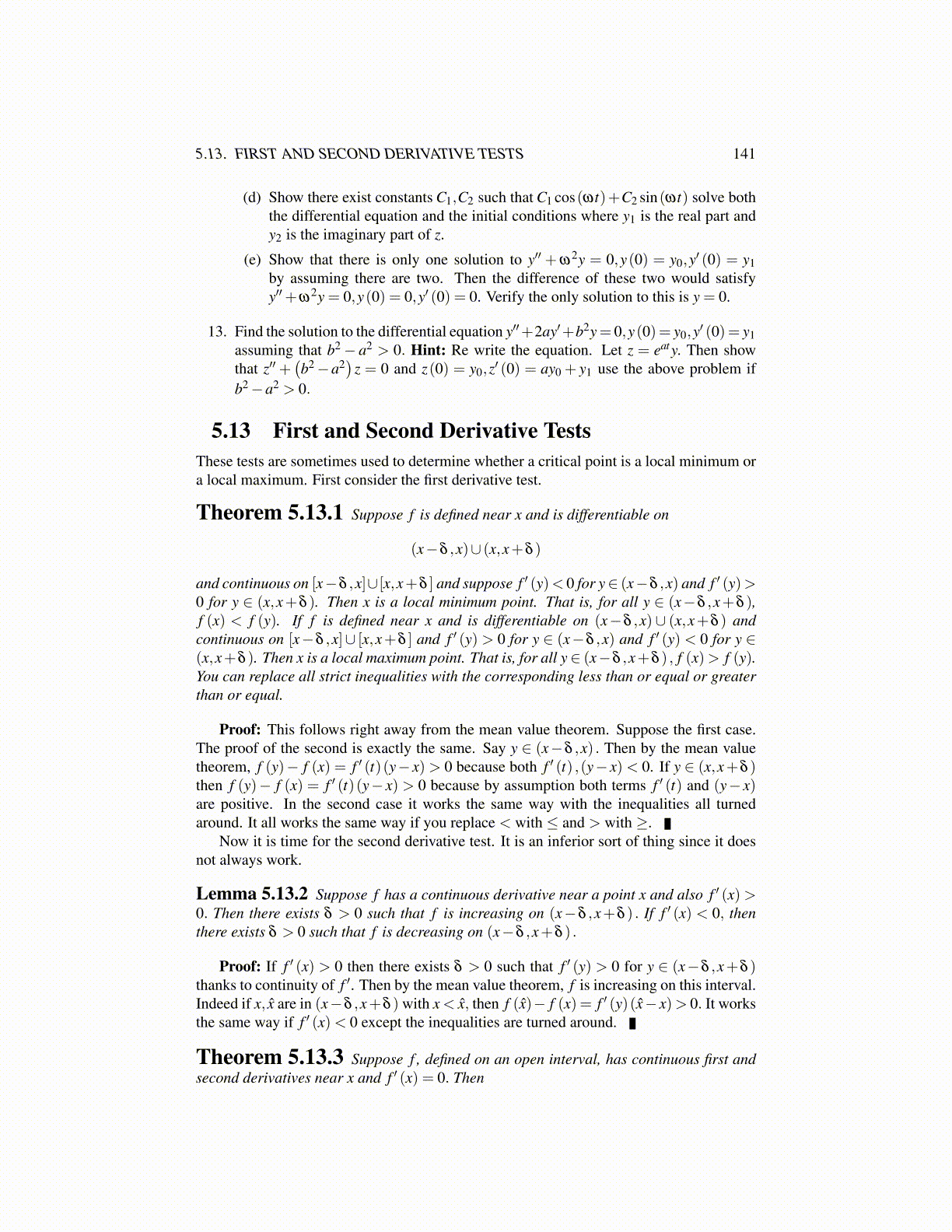
5.13. FIRST AND SECOND DERIVATIVE TESTS 141
(d) Show there exist constants C1,C2 such that C1 cos(ωt)+C2 sin(ωt) solve boththe differential equation and the initial conditions where y1 is the real part andy2 is the imaginary part of z.
(e) Show that there is only one solution to y′′ + ω2y = 0,y(0) = y0,y′ (0) = y1by assuming there are two. Then the difference of these two would satisfyy′′+ω2y = 0,y(0) = 0,y′ (0) = 0. Verify the only solution to this is y = 0.
13. Find the solution to the differential equation y′′+2ay′+b2y= 0,y(0)= y0,y′ (0)= y1assuming that b2 − a2 > 0. Hint: Re write the equation. Let z = eaty. Then showthat z′′ +
(b2 −a2
)z = 0 and z(0) = y0,z′ (0) = ay0 + y1 use the above problem if
b2 −a2 > 0.
5.13 First and Second Derivative TestsThese tests are sometimes used to determine whether a critical point is a local minimum ora local maximum. First consider the first derivative test.
Theorem 5.13.1 Suppose f is defined near x and is differentiable on
(x−δ ,x)∪ (x,x+δ )
and continuous on [x−δ ,x]∪ [x,x+δ ] and suppose f ′ (y)< 0 for y∈ (x−δ ,x) and f ′ (y)>0 for y ∈ (x,x+δ ). Then x is a local minimum point. That is, for all y ∈ (x−δ ,x+δ ),f (x) < f (y). If f is defined near x and is differentiable on (x−δ ,x)∪ (x,x+δ ) andcontinuous on [x−δ ,x]∪ [x,x+δ ] and f ′ (y) > 0 for y ∈ (x−δ ,x) and f ′ (y) < 0 for y ∈(x,x+δ ). Then x is a local maximum point. That is, for all y ∈ (x−δ ,x+δ ) , f (x)> f (y).You can replace all strict inequalities with the corresponding less than or equal or greaterthan or equal.
Proof: This follows right away from the mean value theorem. Suppose the first case.The proof of the second is exactly the same. Say y ∈ (x−δ ,x) . Then by the mean valuetheorem, f (y)− f (x) = f ′ (t)(y− x)> 0 because both f ′ (t) ,(y− x)< 0. If y ∈ (x,x+δ )then f (y)− f (x) = f ′ (t)(y− x) > 0 because by assumption both terms f ′ (t) and (y− x)are positive. In the second case it works the same way with the inequalities all turnedaround. It all works the same way if you replace < with ≤ and > with ≥.
Now it is time for the second derivative test. It is an inferior sort of thing since it doesnot always work.
Lemma 5.13.2 Suppose f has a continuous derivative near a point x and also f ′ (x)>0. Then there exists δ > 0 such that f is increasing on (x−δ ,x+δ ) . If f ′ (x) < 0, thenthere exists δ > 0 such that f is decreasing on (x−δ ,x+δ ) .
Proof: If f ′ (x) > 0 then there exists δ > 0 such that f ′ (y) > 0 for y ∈ (x−δ ,x+δ )thanks to continuity of f ′. Then by the mean value theorem, f is increasing on this interval.Indeed if x, x̂ are in (x−δ ,x+δ ) with x < x̂, then f (x̂)− f (x) = f ′ (y)(x̂− x)> 0. It worksthe same way if f ′ (x)< 0 except the inequalities are turned around.
Theorem 5.13.3 Suppose f , defined on an open interval, has continuous first andsecond derivatives near x and f ′ (x) = 0. Then